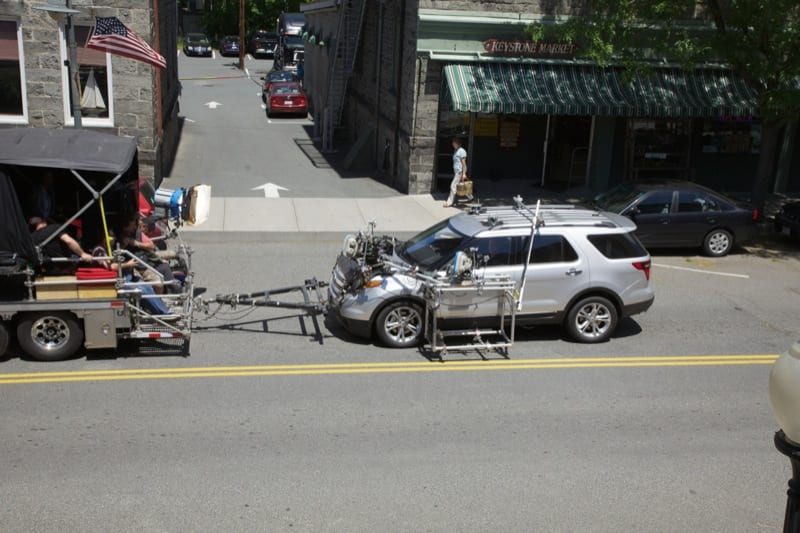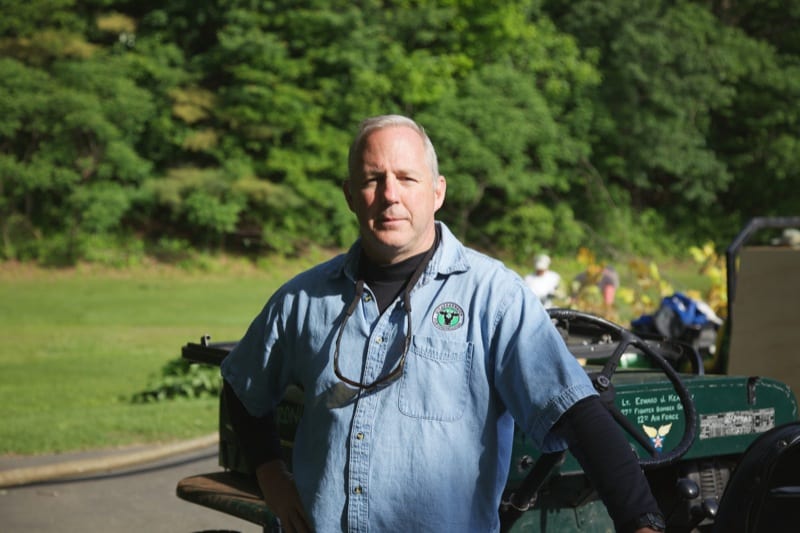I spend about a third of my time in Shelburne Falls, Massachusetts. In an otherwise quiet little town, I was fortunate enough to find myself sitting in my apartment overlooking Bridge Street doing an interview with Joe Kearney. Joe is the Construction Coordinator for The Judge, a major motion picture being filmed right outside my window by Warner Brothers.
The film is about a successful lawyer (Robert Downey, Jr.) who returns to his hometown for his mother’s funeral, only to discover that his estranged father (Robert Duvall), the town’s judge, is suspected of murder. Billy Bob Thornton is also in the cast. This Joe Kerney interview is fortuitous because Joe handles a lot of tools working with the sets associated with this feature film.
For the last few days, Joe’s team has transformed the town of Shelburne Falls, Massachusetts, into Carlinville, Indiana. Buildings have been repainted, signs have been placed over existing storefronts and even road signs have been changed. Miles of wire has been strung in the alleys and byways leading to Bridge Street (our main thoroughfare) and connected to Warner Brothers’ generators. This is to power the numerous huge ARRI lights used in filming. They are even putting new lampposts in front of our apartment over Greenfield Savings (now Carlenville Savings). A helicopter with a huge camera has also been spotted overhead and is being used extensively for driving shots.
Joe Kearney Interview
Ernie Conover (Ernie): Joe, do you work as a construction coordinator exclusively for Warner Brothers?
Joe Kearney (Joe): No, I work for all studios: Sony, Paramount, Universal, and Warner Brothers to name a few of the major ones.
Ernie: So your work could take you anywhere?
Joe: Yes, and it has. I just happen to live here in Shelburne Falls, and it’s the town I grew up in. Massachusetts also has a great tax incentive for the movie business, so it frequently draws productions here. I’m happy to be working so close to home, having spent about ten years in L.A. and five years on the road. I’ve been able to call Boston home as well, and I have a shop there with a 30-man crew turning out movie sets. I spend five days a week in Boston and the weekends here in Shelburne Falls.
Working in Film
Ernie: Tell us a little about your job.
Joe: As a construction coordinator I am basically responsible for everything I have no control over! If you accept those parameters, you can stay sane. Things will change all the time, and you have to make everything work. My biggest responsibility is to budget the construction. Above that, I provide all of the tools for the construction crews, and I also oversee the painters, greens department laborers, and plasterers. There are four or five departments that fall under the jurisdiction of construction.
Ernie: What’s your construction background?
Joe: I went into construction shortly after school, deciding that dairy farming was not my life’s work. I worked general construction for a while but then got into building movie sets.
Ernie: In building movie sets you traveled all over the country. How do you work out the logistics of getting everything where it needs to be at a specific time?

Joe: That can be really hard. We did a show in Alaska, for example, where everything was seven to ten days away because it all had to be floated up by barge. So when you ordered anything, you wanted to make sure you ordered a little heavy! I have also worked in Mexico City where nobody has any tools at all, and the power tools you bring are going to be used so much, they will be worthless by the time the show is done. Logistics are the same in principle anywhere—you have to plan ahead at the onset and try to stay ahead of the game during construction.
Joe Kearney on Transforming a Town
Ernie: Watching you transform the town of Shelburne Falls, Massachusetts, into Carlinville, Indiana, has been nothing short of amazing. As a fellow woodworker, I see that you have to work very fast and efficiently, but everything you do also has to be reversible. How do your fabrication methods differ from what we would expect to find in more traditional construction?
Joe: We build quickly, and we don’t build to last! We want lightweight construction that will go in easily. This is mostly because, if we cause a lot of damage, we will have more to restore on removal. Everything is built very lightweight with 1/4” lauan plywood glued and stapled to 1x3s every two-feet on-center. The face side is generally plastered. You pay the price for this lightweight construction—sometimes the weather will bubble lauan a bit between the large two-foot spans. Generally, it ends up looking good in the finished film.
The main thing is you still have to be a good carpenter. A miter is still a miter, and it has to meet perfectly. The lingo in the movie business is different, but a good carpenter is a good carpenter! Actually, a lot of what we do is overkill, and sometimes the camera doesn’t even see it. Nevertheless, you still have to do the best job possible, which is what the art director and the designer want. Compared to other movies I have worked on, this is a very simple build. It’s just the tip of the iceberg compared to what’s called for [in more complex set designs]. I have 15 or 20 guys out here working on The Judge, but back in Boston, I have 50 employees in the shop building all of the interiors for any number of movies.
Transforming a Town
Ernie: I have seen you hang many a sign over, or in place of, existing signs. One, in particular, is solid bronze and heavy. These would have to be secured for safety reasons. Are there any pet fasteners, adhesives, tapes, and such that you have found to be go-to products?

Joe: Well, yes. For anything that has a safety factor, I love being able to drill into the mortar with a Tapcon to secure the item. No shield, just a concrete screw. That is my favorite thing because I only have to drill into the mortar. Usually, the building owners are OK with that. They definitely don’t like drilling into the brick because I can repack the mortar and tell them that it will be just as good. I will favor any kind of mechanical fastener over tape because heat affects the grip of most adhesives.
For less critical applications they make some great stuff out in Los Angeles called Joe’s Sticky Tape. It’s a clear butyl tape made for the movie industry that sticks great but removes easily with no residue. It’s very expensive—about $20 for a 1-inch x 20-foot roll. At 1/16” thick, it really has some holding power.
We also use a lot of Velcro, and I will hook over with a hanger any time I can. Sometimes I use a hanger in addition to tape for added safety. Still, sometimes we get caught. As things heat up, a sign will occasionally fall. And other times, when we go to remove a sign, it won’t come off! That’s when we have to pay for a new sign, but I would rather do that than take a chance of it falling and hurting someone.
Favorite Set Design Tools
Ernie: With all this in mind, are there favorite tools you employ in working your movie magic?
Joe: Well, the go-to tool is obviously the impact driver (Joe and his crew often refer to this as an “impact gun” on the set). The impact driver has really changed the game of driving fasteners in this business. No one has uses a screw gun anymore, even though ten years ago they were all the rage. Once the impact came along, we quickly realized that nothing hits like it. You can drive a 4” or 5” TimberLOK screw with no problem.
Ernie: And you can bring every screw right down flush without breaking them.
Joe: Every time. Every time—they’re unbelievable! I probably had the first impact driver in L.A., when nobody knew what they were, and they were so loud. In fact, they were so loud that I never thought the impact gun would take off, but they have. People have gotten used to them, and it’s been a great, great tool. It’s definitely our primary tool and even more important than a hammer, which we rarely use.
Joe Kearney Interview – Your Favorite Brand?
Ernie: And following on that, are there any brands you prefer?
Joe: I think the best brand is the Makita (Editor: Check out our review of the Makita LXDT08 18V impact driver). I have a bunch of DeWalt tools (see our review of the DeWalt DCF886M2 XR brushless impact driver), but the Makitas are lightweight, and they have a lot of torque—a lot of punch, anyway. Their batteries seem to hold up, and the overall design of the tool seems perfect for what we do. The DeWalts are also good. They’re solid and they’re rugged, but the ones I have are not quite as form-fitting as I think the Makita’s are.
Ernie: You use all 18-volt tools, then?
Joe: Yes, 18-volt tools are the perfect weight-to-power ratio. The guys can carry an 18 volt on their belt all day, and it has enough power for most tasks. Cordless tools are essential for this business, but if I do end up needing anything more powerful, I’m going to run a cord.
Extracurricular Fun
Ernie: What do you do for fun when you’re not building movie sets?
Joe: I am having a good time working on a house I bought here in Shelburne Falls. I also have a Willys Jeep that I’ve had for many years, and I ride a motorcycle.

Joe: On this movie set, 100% are from Massachusetts. On some of the bigger movies I will bring in 40 to 50 people from L.A. For Rest In Peace Department (R.I.P.D.), which came out this summer, I had a crew of 250 that worked for 9 months.
Ernie: Before we wrap up, I’d be remiss if I didn’t ask: How can one of our readers become a carpenter in the movie business?
Joe: Here in the Northeast, you have to join the Studio Mechanics (I.A.T.S.E.) Local 481 union, which is based in Boston. To join, you have to be a resident in New England, have a sponsor, and be voted in. There is also a $1,100 application and initiation fee as well as $300 in annual dues.
That’s a Wrap!
I didn’t want to take up too much more of Joe’s time, so we wrapped up our interview, and Joe continued his work on the production. We want to thank Joe for agreeing to be interviewed about his work as a construction coordinator for feature film set design and carpentry. It’s certainly an interesting take on the specialized work that film production carpenters do, and it was fascinating to hear about the differences and particulars of this style of work.
If you are an industry professional with an interesting or unusual job, or if you have an interesting story to share about how a particular tool or technology works, please feel free to send us a note at info AT protoolreviews.com, and we can consider using it in a future article or contacting you to get more information.


